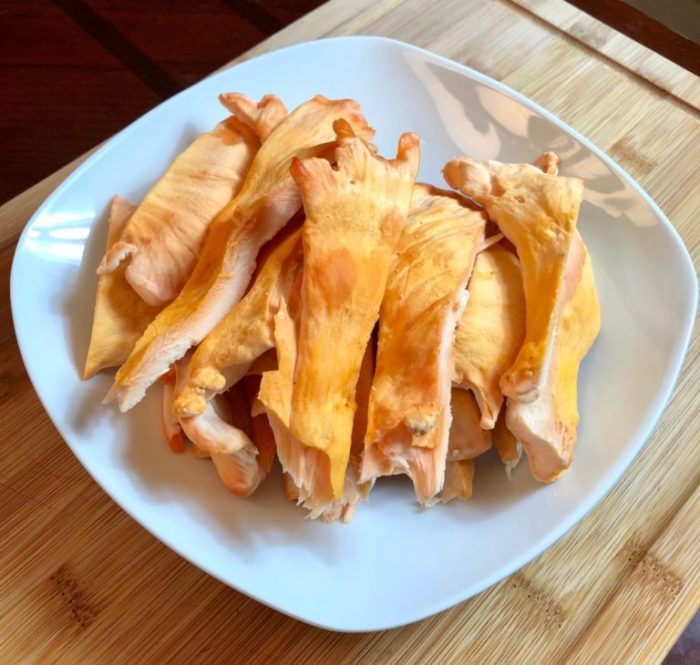
Chicken of the woods recipe – Embark on a culinary adventure with our comprehensive guide to the delectable chicken of the woods mushroom. From grilling to sautéing, we’ll uncover the secrets to unlocking its unique flavors and maximizing its nutritional value. So grab your aprons and prepare to savor the wild bounty of nature.
With its vibrant orange hue and succulent texture, chicken of the woods is a culinary gem that offers a meaty alternative to traditional proteins. Whether you’re a seasoned chef or a curious home cook, this guide will provide you with the knowledge and inspiration to create mouthwatering dishes that showcase this extraordinary ingredient.
Cooking Methods
Chicken of the woods is a versatile mushroom that can be cooked in a variety of ways. Some of the most popular methods include grilling, sautéing, and roasting.
Each method has its own advantages and disadvantages. Grilling is a great way to get a smoky flavor on the mushrooms, while sautéing is a quick and easy way to cook them. Roasting is a good option for larger pieces of chicken of the woods, as it allows them to cook evenly.
Flavor Profiles
Chicken of the woods boasts a unique flavor profile that sets it apart from other mushrooms. Its meaty texture and savory taste make it a versatile ingredient that can be used in various dishes.
The mushroom’s natural flavors can be enhanced by complementary ingredients and seasonings. Herbs such as thyme, rosemary, and sage add a woodsy aroma, while spices like garlic, onion, and paprika provide depth and warmth. Aromatics such as shallots and leeks add sweetness and complexity.
Marinades, Sauces, and Rubs
Marinating chicken of the woods in a mixture of olive oil, soy sauce, and spices can infuse it with flavor. Sauces made with white wine, butter, and herbs can enhance the mushroom’s savory taste. Dry rubs using a combination of herbs, spices, and salt can create a crispy exterior while locking in the mushroom’s natural juices.
Nutritional Value

Chicken of the woods is a nutritionally rich mushroom, boasting an impressive profile of protein, fiber, and vitamins. It contains all essential amino acids, making it a complete protein source for vegetarians and vegans.
Compared to other edible mushrooms, chicken of the woods stands out for its high protein content. It provides about 10-15% of its dry weight in protein, significantly higher than the 2-5% found in common button mushrooms or oyster mushrooms.
Fiber
Chicken of the woods is also an excellent source of dietary fiber, which is crucial for digestive health and blood sugar regulation. It contains both soluble and insoluble fiber, contributing to feelings of fullness and promoting regular bowel movements.
Vitamins and Minerals
In terms of vitamins, chicken of the woods is a good source of vitamin D, which is essential for bone health. It also contains significant amounts of vitamins B1, B2, and B3, as well as minerals like potassium, iron, and zinc.
If you’re looking for a delicious and unique way to enjoy mushrooms, look no further than the chicken of the woods recipe . This edible mushroom has a meaty texture and a slightly sweet flavor, making it a great substitute for chicken in many dishes.
Whether you’re grilling, sautéing, or roasting it, you’re sure to enjoy this flavorful and versatile mushroom.
Health Benefits
The nutritional value of chicken of the woods makes it a valuable addition to a balanced diet. Its high protein and fiber content supports weight management, muscle growth, and satiety. The presence of vitamins and minerals contributes to overall health and well-being.
Furthermore, studies have shown that chicken of the woods possesses antioxidant and anti-inflammatory properties, which may offer protection against chronic diseases such as heart disease and cancer.
Safety Precautions

Identifying chicken of the woods accurately is crucial before consuming it to avoid potential health risks. Distinguishing edible chicken of the woods from potentially toxic lookalikes requires careful observation and knowledge of its key characteristics.
When foraging for chicken of the woods, pay attention to its appearance, texture, and growing substrate. Edible chicken of the woods typically has bright orange to yellow pores on the underside of the cap, while toxic lookalikes may have white, gray, or brown pores.
Additionally, edible chicken of the woods is usually firm and fleshy, while toxic lookalikes may be soft and spongy.
Lookalikes and Toxic Species, Chicken of the woods recipe
- False Chicken of the Woods (Hypholoma fasciculare): This toxic species has yellow to greenish-yellow caps with crowded gills instead of pores. It grows on decaying wood, unlike edible chicken of the woods, which grows on living trees.
- Jack-o’-Lantern Mushroom (Omphalotus illudens): This poisonous mushroom has bright orange caps with gilled undersides and a bioluminescent glow in the dark. It grows on decaying wood and can cause severe gastrointestinal distress.
- Sulphur Tuft (Hypholoma capnoides): This toxic species has sulfur-yellow caps with crowded gills and a bitter taste. It grows on decaying wood and can cause nausea and vomiting.
If you are unsure about the identity of a mushroom, it is always best to err on the side of caution and avoid consuming it. Consult with experienced mushroom foragers or use field guides to ensure proper identification before consuming chicken of the woods or any other wild mushrooms.
Recipe Variations: Chicken Of The Woods Recipe
Chicken of the woods offers a versatile culinary canvas, allowing for a wide range of recipes that cater to various tastes and dietary preferences. From simple sautéed dishes to hearty casseroles, there’s a chicken of the woods recipe for every occasion.
Whether you’re a vegan, vegetarian, or gluten-free eater, you can enjoy the delicious flavors of chicken of the woods. Here are some recipe variations to inspire your next culinary adventure:
Sautéed Chicken of the Woods
- Ingredients: Chicken of the woods, olive oil, salt, pepper
- Instructions: Heat olive oil in a skillet over medium heat. Add chicken of the woods and cook until browned on all sides. Season with salt and pepper to taste.
- Serving suggestions: Serve as a side dish or as a topping for salads, tacos, or sandwiches.
Chicken of the Woods Casserole
- Ingredients: Chicken of the woods, potatoes, carrots, celery, onion, chicken broth, cream of mushroom soup, salt, pepper
- Instructions: Preheat oven to 375°F (190°C). In a large skillet, sauté chicken of the woods, potatoes, carrots, celery, and onion until softened. Stir in chicken broth, cream of mushroom soup, salt, and pepper. Pour into a casserole dish and bake for 30-45 minutes, or until bubbly and heated through.
The chicken of the woods recipe is a great way to use up fresh mushrooms. This mushroom can be found in forests all over the world, and it’s typically found growing on dead or dying trees. If you’re lucky enough to find some, be sure to give this recipe a try.
You won’t be disappointed!
- Serving suggestions: Serve hot with crusty bread or a side salad.
Vegan Chicken of the Woods Tacos
- Ingredients: Chicken of the woods, taco seasoning, tortillas, vegan sour cream, vegan cheese, salsa, guacamole
- Instructions: Season chicken of the woods with taco seasoning and sauté until cooked through. Heat tortillas in a skillet or microwave. Fill tortillas with chicken of the woods, vegan sour cream, vegan cheese, salsa, and guacamole.
- Serving suggestions: Serve with your favorite taco toppings, such as lettuce, tomatoes, onions, or cilantro.
Vegetarian Chicken of the Woods Stir-Fry
- Ingredients: Chicken of the woods, tofu, vegetables of your choice (such as broccoli, carrots, bell peppers), soy sauce, sesame oil, honey
- Instructions: Heat sesame oil in a wok or large skillet over medium heat. Add chicken of the woods and tofu and cook until browned. Add vegetables and cook until softened. Stir in soy sauce, honey, and any other seasonings to taste.
- Serving suggestions: Serve over rice or noodles.
Gluten-Free Chicken of the Woods Soup
- Ingredients: Chicken of the woods, potatoes, carrots, celery, onion, chicken broth, gluten-free flour, salt, pepper
- Instructions: In a large pot, sauté chicken of the woods, potatoes, carrots, celery, and onion until softened. Add chicken broth and bring to a boil. In a separate bowl, whisk together gluten-free flour and a little bit of chicken broth to form a slurry.
Gradually add the slurry to the pot, stirring constantly. Season with salt and pepper to taste. Simmer for 30 minutes, or until soup has thickened.
- Serving suggestions: Serve hot with gluten-free bread or crackers.
Final Review

As we conclude our culinary journey, we encourage you to experiment with the versatility of chicken of the woods. Its adaptability to various cooking methods and flavors makes it a true culinary chameleon. Whether you prefer the smoky notes of grilling or the aromatic flavors of sautéing, the possibilities are endless.
Remember, proper identification is crucial before consuming any wild mushroom. Consult with experts or refer to reliable resources to ensure you’re harvesting the true chicken of the woods. With its nutritional benefits and delectable taste, this forest delicacy is sure to become a staple in your culinary repertoire.
User Queries
What are the key characteristics of chicken of the woods?
Chicken of the woods is known for its bright orange color, meaty texture, and mild, slightly nutty flavor.
Is chicken of the woods safe to eat?
Yes, chicken of the woods is generally considered safe to eat when properly identified and cooked. However, it’s crucial to consult with experts or refer to reliable resources to avoid consuming lookalikes.
What are some cooking methods suitable for chicken of the woods?
Chicken of the woods can be grilled, sautéed, roasted, or added to soups and stews. Each method imparts unique flavors and textures.